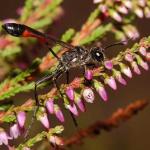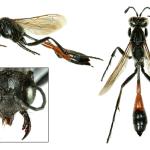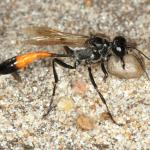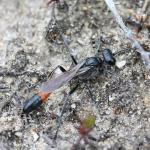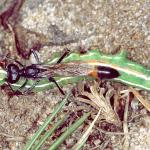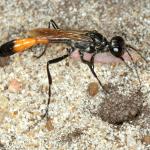This is a very close relative of Ammophila sabulosa; in many of its sites it flies with its congener, and may be locally abundant.
Restricted mainly to the southern counties of England, with most records from West Sussex, Hampshire, east Dorset, Berkshire and Surrey. Has also occurred in west Wales, Oxfordshire, East Kent, Suffolk, Worcestershire, Nottinghamshire, and Lancashire, also Jersey (Saunders, 1902).
Not listed in the Red Data Book (Shirt 1987) or in Falk (1991). In view of its restricted distribution and dependence on a threatened habitat, this wasp may now be under threat.
Dry heathlands. In Jersey, it occurs on coastal dunes.
Usually larvae of Lepidoptera; rarely those of sawflies (Symphyta).
Unlike A. sabulosa, this is one of several Ammophila species known to provision its cells progressively and maintain more than one nest simultaneously. It was the subject of one of the classic early studies of animal behaviour in The Netherlands (see Baerends, 1941; Tinbergen, 1958 — the species was then misidentified as A. campestris). Nests are short, unicellular burrows dug in the sand, and often occur in aggregations. Each is provisioned with about six larvae. As in A. sabulosa, the first caterpillar is carried into the cell and oviposited on. However, instead of completing the provisioning of this first nest before the egg hatched, Baerends found that typically a female would next dig a second burrow, provision it with one caterpillar, and oviposit. She would then re-open the first burrow and, if her inspection revealed that its egg had hatched, would proceed to add one to three further prey for the developing wasp larva. The second burrow would then be inspected and further provisioned. Finally, each burrow would be inspected again, and three to seven further prey added, before final closure and the digging of new burrows. Occasionally, a third burrow would be dug before the first two had been provisioned. See Olberg (1959) for additional text and illustrations. The observations above indicate that a female is capable of remembering the locations of two or three separate nests simultaneously. Baerends used ingenious experiments to show that females use landmarks to learn the location of each nest. Artificial trees were placed near the nesting area and left until the wasps had learned to use them as landmarks. When a tree was experimentally moved, say 5 m to the west, then the wasp searched for its nest 5 m west of its real position. It thus appeared to locate its nest from the nest's position relative to the landmark. These experiments, together with others using artificial nests, partly explained how a female could achieve the incredible feat of caring for two or three nests simultaneously, each at a different stage of development and therefore requiring different amounts of food.
Mainly bramble (Rubus fruticosus agg.), heather (Calluna vulgaris) and bell heather (Erica cinerea).
Profile written: 1997
Proofed: March 2012


